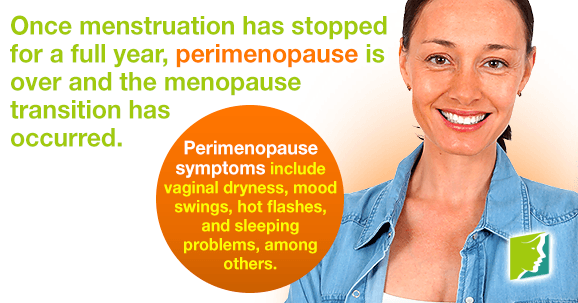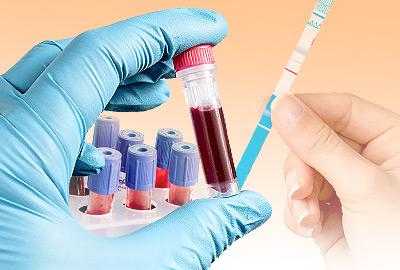Perimenopause means “around menopause” and refers to the period of time leading up to menopause, one year after a woman's last period. It is different for every woman depending on lifestyle and genetics, but the majority of women begin to experience symptoms of menopause in their 40s. During perimenopause, estrogen levels are fluctuating, causing irregular menstrual cycles. Once menstruation has stopped for a full year, perimenopause is over and menopause has begun. Symptoms may lessen once menopause starts, but they could persist. It is important to maintain a healthy and active lifestyle in order to prevent these symptoms.
Common Symptoms
While each woman's experience is different, these are the most frequently-reported perimenopause symptoms:
Irregular menstruation. Experiencing inconsistencies in your menstrual cycle is normal. Many women begin to notice the length of time between periods may be longer or shorter than usual, their flow is light or heavy, or skipped periods.
Hot flashes. Many women experience hot flashes well into menopause, but they can begin in early perimenopause.
Sleeping problems. Hormone fluctuations during perimenopause can be caused by insomnia and night sweats.
Mood swings. Some women experience mood swings, irritability, or increased risk of depression during perimenopause.
Vaginal and bladder issues. Estrogen fluctuations can result in vaginal dryness, causing painful intercourse and higher risk of infection.
Changes in sex drive. Some women experience a drop in libido during the menopause transition. However, if you have a healthy sex drive to begin with, it is likely that it will not be affected very much.
Bone loss. Women become at higher risk of osteoporosis during perimenopause because low estrogen levels cause a decrease in bone density.
Cholesterol changes. Decreasing estrogen levels can cause changes in cholesterol levels, increasing the risk of heart disease.
Symptoms typically fade after menopause, the average age of which is 51. However, some women experience menopause as late as age 55, and in rare cases, even older.
Managing Perimenopause
Simple lifestyle changes, in addition to promoting overall better health, are a necessary tool to keep bothersome perimenopause symptoms at bay.
Eat healthy. Eating healthy can help prevent some of these frustrating perimenopause symptoms. Maintaining a balanced diet that is low in fat, high in fiber, and rich in fruits, vegetables, and whole grains is ideal. Essential fatty acids - like salmon and avocado - are also very beneficial.
Exercise. Getting regular exercise can significantly increase energy, lift mood, and improve the quality of sleep. The general recommendation is around 30 minutes of aerobic activity five times a week. Cycling, walking, and swimming are all excellent low-impact workouts.
Reduce stress. Practicing yoga or meditation can help promote overall health and relaxation. Reducing stress is key to preventing perimenopause symptoms like insomnia and mood swings.
Herbal remedies. Herbs like black cohosh and red clover have been shown to help ease perimenopause symptoms and increase estrogen levels. These herbs are available in supplement or tea form.
Perimenopause refers to the period of time leading up to menopause. While it affects every woman differently, many women experience some of the featured symptoms to some degree during this time. It is important to know that symptoms begin to lessen with time, and maintaining a healthy and active lifestyle can help prevent and manage these bothersome symptoms. Read more about how to stop perimenopause symptoms.
Sources
- Mayo Clinic Staff. (2013). Perimenopause. Retrieved December 3, 2014, from http://www.mayoclinic.org/diseases-conditions/perimenopause/basics/alternative-medicine/con-20029473
- Office on Women's Health. (2010). Menopause basics. Retrieved December 3, 2014, from http://www.womenshealth.gov/menopause/menopause-basics/index.html




